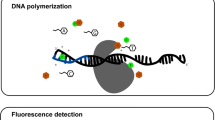Abstract
Single-stranded DNA (ssDNA) generation is a crucial step in several molecular biology applications, such as sequencing or DNA chip and microarray technology. Molecules of ssDNA also play a key role in the selection of ssDNA aptamers through Systematic Evolution of Ligands by EXponential enrichment (SELEX). With particular interest for this application, herein we present a comparative study of the most used methods for generation of ssDNA used in SELEX, such as asymmetric PCR, enzyme digestion and magnetic separation with streptavidin beads. In addition, we evaluate a new technique that combines asymmetric PCR and enzyme digestion with the aim to achieve the maximum efficiency in ssDNA generation. The methods studied were compared in terms of quality of ssDNA using electrophoretic analysis and generated ssDNA yields were quantitatively measured using an Enzyme-Linked OligoNucleotide Assay (ELONA).




Similar content being viewed by others
References
Ellington AD, Szostak JW (1990) In vitro selection of RNA molecules that bind specific ligands. Nature 346:818–822
Robertson DL, Joyce GF (1990) Selection in vitro of an RNA enzyme that specifically cleaves single-stranded DNA. Nature 344:467–468
Tuerk C, Gold L (1990) Systematic evolution of ligands by exponentional enrichment: RNA ligands to bacteiophage T4 DNA polymerase. Science 249:505–510
Espelund M et al (1990) A simple method for generating single-stranded DNA probes labeled to high activities. Nucleic Acids Res 18:6157–6158
Hultman T et al (1989) Direct solid-phase sequencing of genomic and plasmid DNA using magnetic beads as solid support. Nucleic Acids Res 17:4937–4946
Stoltenburg R et al (2005) FluMag-SELEX as an advantageous method for DNA aptamer selection. Anal Bioanal Chem 383:83–91
Walder RY et al (1993) Use of PCR primers containing a 3′-terminal ribose residue to prevent cross-contamination of amplified sequences. Nucleic Acids Res 21:4339–4343
Wiliams KP, Bartel DP (1995) PCR product with strands of unequal length. Nucleic Acids Res 23:4220–4221
Gyllensten UB, Erlich HA (1988) Generation of single-stranded DNA by the polymerase chain reaction and its application to direct sequencing of the HLA-DQA locus. Proc Natl Acad Sci USA 85:7652–7656
Wu L, Curran J (1999) An allosteric synthetic DNA. Nucleic Acids Res 27:1512–1516
Nadal P et al (2011) DNA Aptamers against the Lup an 1 Food Allergen. PLoS One 7:e35253
Nikiforov TT et al (1994) The use of phosphorothioate primers and exonuclease hydrolysis for the preparation of single-stranded PCR products and their detection by solid-phase hybridization. Cold Spring Harbor Lab Press 3:285–291
Avci-Adali M et al (2010) Upgrading SELEX technology by using lambda exonuclease digestion for single-stranded DNA generation. Molecules 15:1–11
Higuchi RG, Ochman H (1989) Production of single-stranded DNA templates by exonuclease digestion following the polymerase chain reaction. Nucleic Acids Res 17:5865
Marimuthu C et al (2011) Conditions optimized for the preparation of single-stranded DNA (ssDNA) employing lambda exonuclease digestion in generating DNA aptamer. World J Microbiol Biotechnol 27:1167–1173
Dickman M, Hornby DP (2000) Isolation of single-stranded DNA using denaturing DNA chromatography. Anal Biochem 284:164–167
Diggle MA, Clarke SC (2003) A novel method for preparing single-stranded DNA for Pyrosequencing (TM). Mol Biotechnol 24:221–224
Groth M et al (2006) Method for preparing single-stranded DNA templates for Pyrosequencing using vector ligation and universal biotinylated primers. Anal Biochem 356:194–201
Stahl S et al (1988) Solid-phase DNA sequencing using the biotin–avidin system. Nucleic Acids Res 16:3025–3038
Rehbein H et al (1998) Comparison of different methods to produce single-stranded DNA for identification of canned tuna by single-strand conformation polymorphism analysis. Electrophoresis 19:1381–1384
Dziembowski A, Stepien PP (2001) Analysis of 3′ and 5′ ends of RNA by solid-phase S1 nuclease mapping. Anal Biochem 294:87–89
Beaulieu M et al (2001) PCR candidate region mismatch scanning: adaptation to quantitative, high-throughput genotyping. Nucleic Acids Res 29:1114–1124
Laveder P et al (2002) A two-step strategy for constructing specifically self-subtracted cDNA libraries. Nucleic Acids Res 30:e38
Brinker A et al (2010) Lambda exonuclease pre-treatment for improved DNA-chip performance depends on the relative probe-target position. Biosens Bioelectron 26:898–902
Gao HF et al (2003) Comparison of different methods for preparing single stranded DNA for oligonucleotide microarray. Anal Lett 36:2849–2863
Marimuthu C et al (2012) Single-Stranded DNA (ssDNA) production in DNA aptamer generation. Analyst 137:1307–1315
Kaltenbboeck B, Kousoulas KG (1996) PCR sequencing protocols. Methods Mol Biol 65:149–153
Paul A et al (2009) Streptavidin-coated magnetic beads for DNA a multitude of problems during cell-SELEX. Oligonucleotides 19:243–254
Wilson R (2011) Preparation of single-stranded DNA from PCR products with streptavidin magnetic beads. Nucleic Acid Ther. doi:10.1089nat.2011.0322
Srisawat C, Engelke DR (2001) Streptavidin aptamers: affinity tags for the study of RNAs and ribonucleoproteins. RNA 7:632–641
Tahiri-Alaoui A et al (2002) High affinity nucleic acid aptamers for streptavidin incorporated into bi-specific capture ligands. Nucleic Acids Res 30:e45
James W (2000) Aptamers. Encycl Anal Chem 4848–4871
Fukusaki E et al (2001) SELEX for tubulin affords specific T-rich DNA aptamers. Bioorg Med Chem Lett 11:2927–2930
Wang CL et al (2003) Single-stranded DNA aptamers that bind differentiated but not parental cells: subtractive systematic evolution of ligands by exponential enrichment. J Biotechnol 102:15–22
Acknowledgement
M.S. acknowledges the support from a FI predoctoral scholarship of the Generalitat de Catalunya, and Recercaixa for the project Aptalup as well as the FP7-ICT-7 Project D-Liver, Grant Agreement no. 287596.
Author information
Authors and Affiliations
Corresponding author
Rights and permissions
About this article
Cite this article
Svobodová, M., Pinto, A., Nadal, P. et al. Comparison of different methods for generation of single-stranded DNA for SELEX processes. Anal Bioanal Chem 404, 835–842 (2012). https://doi.org/10.1007/s00216-012-6183-4
Received:
Accepted:
Published:
Issue Date:
DOI: https://doi.org/10.1007/s00216-012-6183-4




